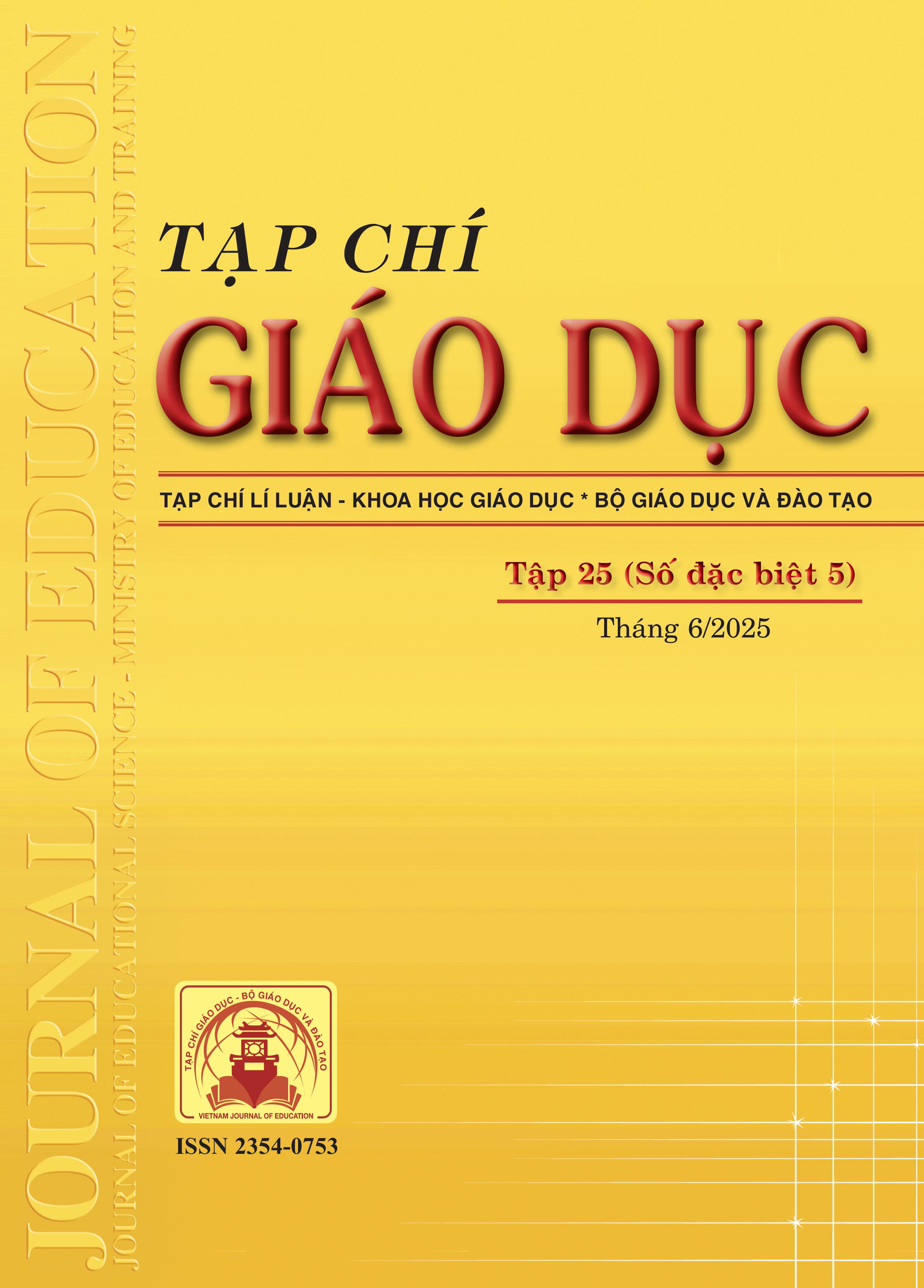Sử dụng phương pháp phân tích tranh vẽ để khám phá quan niệm học tập của học sinh lớp 5
Tóm tắt
To explore the different ways primary students understand and interpret their own learning, the present research focuses on identifying their conceptions of learning. A phenomenographic approach was employed through drawing analysis. A total of 76 fifth grade students in Hanoi were asked to depict their conceptualization of learning by drawing. A coding checklist was adapted to analyze the components in the drawings. Seven conceptions of learning were found. In addition, three major findings about the way students perceive learning were discovered: (a) learning tends to happen at school, (b) learning is being passive rather than active and (c) there is a particular interest in Mathematics.
Tài liệu tham khảo
Boulton‐Lewis, G. M., Wilss, L., & Lewis, D. C. (2001). Changes in conceptions of learning for Indigenous Australian university students. British Journal of Educational Psychology, 71(2), 327-341.
Bộ GD-ĐT (2006). Quyết định số 16/2006/QĐ-BGDĐT ngày 05/5/2006 ban hành Chương trình giáo dục phổ thông.
Creswell, J. W. (2007). Qualitative inquiry and research design: Choosing among five approaches (2nd ed.). Thousand Oaks, CA: Sage.
Farokhi, M., & Hashemi, M. (2011). The analysis of children’s drawings: social, emotional, physical, and psychological aspects. Procedia-Social and Behavioral Sciences, 30, 2219-2224.
Harrison, L. J., Clarke, L., & Ungerer, J. A. (2007). Children’s drawings provide a new perspective on teacher–child relationship quality and school adjustment. Early Childhood Research Quarterly, 22(1), 55-71.
Hsieh, W. M., & Tsai, C. C. (2016). Learning illustrated: An exploratory cross-sectional drawing analysis of students’ conceptions of learning. The Journal of Educational Research, 111(2), 139-150.
Hsieh, W. M., & Tsai, C. C. (2017). Exploring students’ conceptions of science learning via drawing: a crosssectional analysis. International Journal of Science Education, 39(3), 274-298.
Hsin, C. T., Liang, J. C., Hsu, C. Y., Shih, M., Sheu, F. R., & Tsai, C. C. (2019). Young children’s conceptions of learning: A cross-sectional study of the early years of schooling. The Asia-Pacific Education Researcher, 28, 127-137. https://doi.org/10.1007/s40299-018-0419-9
Koppitz, E. M. (1966). Emotional indicators on human figure drawings of children: a validation study. Journal of Clinical Psychology, 22(3), 313-315.
Larsson, J., & Holmström, I. (2007). Phenomenographic or phenomenological analysis: Does it matter? Examples from a study on anaesthesiologists’ work. International journal of qualitative studies on health and well-being, 2(1), 55-64.
Marton, F. (1981). Phenomenography—describing conceptions of the world around us. Instructional Science, 10, 177-200. https://doi.org/10.1007/BF00132516
Marton, F., & Booth, S. A. (1997). Learning and awareness. Psychology Press.
Marton, F., Dall’Alba, G., & Beaty, E. (1993). Conceptions of learning. International Journal of Educational Research, 19(3), 277-300.
Nguyễn Xuân Thức (2007). Tìm hiểu hứng thú học tập môn Toán của học sinh lớp 5 tiểu học. Tạp chí Tâm lí học, 4, 6-11.
Peterson, E. R., Brown, G. T., & Irving, S. E. (2010). Secondary school students’ conceptions of learning and their relationship to achievement. Learning and Individual Differences, 20(3), 167-176.
Purdie, N., Hattie, J., & Douglas, G. (1996). Student conceptions of learning and their use of self-regulated learning strategies: A cross-cultural comparison. Journal of Educational Psychology, 88(1), 87-100.
Phan Ngọc (1994). Văn hóa Việt Nam và cách tiếp cận mới. NXB Văn hóa - Thông tin.
Robbers, E., Donche, V., De Maeyer, S., & Van Petegem, P. (2017). A longitudinal study of learning conceptions on the transition between primary and secondary education. Research Papers in Education, 33(3), 375-392.
Säljö, R. (1979). Learning in the learner’s perspective: Some commonsense conceptions. Volume 76 of Reports from the Institute of Education, University of Göteborg.
Sandberg, J. (2000). Understanding human competence at work: an interpretative approach. Academy of Management Journal, 43(1), 9-25. https://doi.org/10.2307/1556383
Tallandini, M. A., & Valentini, P. (1991). Symbolic prototypes in children’s drawings of schools. The Journal of Genetic Psychology, 152(2), 179-190. https://doi.org/10.1080/00221325.1991.9914665
Taylor-Beswick, A. M., & Hornung, E. (2024). Doing phenomenography: a practical guide. Policy Press.
Tran, D., & Javed, S. (2017). Examining non-traditional pathway preservice teachers’ attitudes towards mathematics. In A. Downton, S. Livy, & J. Hall (Eds.), 40 years on: we are still learning!: Proceedings of the 40th Annual Conference of the Mathematics Education Research Group of Australasia (pp. 506-513). MERGA.
Trần Thị Bích Ngân, Phạm Thị Hồng Thắm (2023). Perceptions of Vietnamese Primary school teachers of English about active teaching and learning. Scientific Journal of Tan Trao University, 9(1), 134-147.
Vettori, G., Vezzani, C., Pinto, G., & Bigozzi, L. (2021). The predictive role of prior achievements and conceptions of learning in university success: evidence from a retrospective longitudinal study in the Italian context. Higher Education Research & Development, 40(7), 1564-1577. https://doi.org/10.1080/07294360.2020.1817875
Vygotsky, L. S. (1978). Mind in society: The development of higher psychological processes (Vol. 86). Harvard University Press.
Wallon, H. (1959). Le r-le d-autrui et conscience de soi [The Role of Others and Self-awareness]. Enfance (Evry, France), p. 27986. (Special Issue.)
Wang, H. Y., & Tsai, C. C. (2012). An Exploration of Elementary School Students’ Conceptions of Learning: A Drawing Analysis. The Asia-Pacific Education Researcher, 21(3), 610-617.
Đã Xuất bản
Cách trích dẫn
Số
Chuyên mục
Giấy phép

Tác phẩm này được cấp phép theo Ghi nhận tác giả của Creative Commons Giấy phép quốc tế 4.0 .












